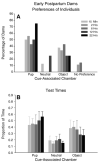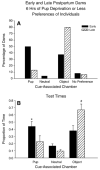Characterization of maternal motivation in the lactating rat: Contrasts between early and late postpartum responses
- PMID: 18457837
- PMCID: PMC2574572
- DOI: 10.1016/j.yhbeh.2008.03.005
Characterization of maternal motivation in the lactating rat: Contrasts between early and late postpartum responses
Abstract
We previously assessed the motivational properties of pups relative to those of cocaine in parturient female rats (dams) across the postpartum period and demonstrated that the larger subset of dams in early postpartum (PPD8) preferred the pup-associated chamber, whereas the majority of dams tested in late postpartum (PPD16) preferred the cocaine-associated chamber [Mattson, B.J., Williams, S., Rosenblatt, J.S., Morrell, J.I. 2001. Comparison of two positive reinforcing stimuli: pups and cocaine throughout the postpartum period. Behav. Neurosci., 115, 683-694; Seip, K.M., Morrell, J.I. 2007. Increasing the incentive salience of cocaine challenges preference for pup- over cocaine-associated stimuli during early postpartum: place preference and locomotor analyses in the lactating female rat. Psychopharmacology 194, 309-319]. The present study uses a dual-choice conditioned place preference to ask how the progression of the postpartum period, including natural pup development, influences maternal motivation for pups. Preferences for cued chambers associated with pups that were age-matched to the postpartum stage of the dam in contrast to a stimulus with little incentive salience were higher during the early than the late postpartum, suggesting that the incentive salience of pups diminishes as the postpartum period progresses. Preferences of the early postpartum dams deprived of pups for 15 min, 2, 6, 12 or 22 hrs prior to conditioning and testing did not differ statistically but there was a trend of more pup preference after 22 hr deprivation; pup age was not an important factor in early postpartum. In marked contrast, late postpartum dams only exhibited robust pup-associated place preference when they were conditioned with young (4-7 day-old) pups or after a 22 hr period of deprivation from contemporaneous pups. Together these results suggest that both forces are at work in the mother-pup dyad, changes in the pups as they develop and changes in the physiological and endocrine state of the female as she progresses through the postpartum period.
Figures






Similar articles
-
Exposure to pups influences the strength of maternal motivation in virgin female rats.Physiol Behav. 2008 Nov 28;95(4):599-608. doi: 10.1016/j.physbeh.2008.09.003. Epub 2008 Sep 9. Physiol Behav. 2008. PMID: 18817796 Free PMC article.
-
Increasing the incentive salience of cocaine challenges preference for pup- over cocaine-associated stimuli during early postpartum: place preference and locomotor analyses in the lactating female rat.Psychopharmacology (Berl). 2007 Oct;194(3):309-19. doi: 10.1007/s00213-007-0841-9. Epub 2007 Jun 23. Psychopharmacology (Berl). 2007. PMID: 17589831 Free PMC article.
-
Preferences for cocaine- or pup-associated chambers differentiates otherwise behaviorally identical postpartum maternal rats.Psychopharmacology (Berl). 2003 Apr;167(1):1-8. doi: 10.1007/s00213-002-1351-4. Epub 2003 Feb 27. Psychopharmacology (Berl). 2003. PMID: 12607073 Free PMC article.
-
NIEHS Report on the Toxicity Studies of Nicotine Bitartrate Dihydrate (CASRN 6019-06-3) Administered in Drinking Water to Sprague Dawley Rats and Swiss Mice: NIEHS Report 11 [Internet].Research Triangle Park (NC): National Institute of Environmental Health Sciences; 2024 Oct. Research Triangle Park (NC): National Institute of Environmental Health Sciences; 2024 Oct. PMID: 39441944 Free Books & Documents. Review.
-
Functional mapping of the neural circuitry of rat maternal motivation: effects of site-specific transient neural inactivation.J Neuroendocrinol. 2011 Nov;23(11):1020-35. doi: 10.1111/j.1365-2826.2011.02200.x. J Neuroendocrinol. 2011. PMID: 21815954 Free PMC article. Review.
Cited by
-
Using seasonality and birdsong to understand mechanisms underlying context-appropriate shifts in social motivation and reward.Horm Behav. 2022 Jun;142:105156. doi: 10.1016/j.yhbeh.2022.105156. Epub 2022 Mar 18. Horm Behav. 2022. PMID: 35313200 Free PMC article. Review.
-
What can challenging reproductive contexts tell us about the rat's maternal behavior?Front Behav Neurosci. 2023 Jul 14;17:1239681. doi: 10.3389/fnbeh.2023.1239681. eCollection 2023. Front Behav Neurosci. 2023. PMID: 37521725 Free PMC article.
-
Exposure to pups influences the strength of maternal motivation in virgin female rats.Physiol Behav. 2008 Nov 28;95(4):599-608. doi: 10.1016/j.physbeh.2008.09.003. Epub 2008 Sep 9. Physiol Behav. 2008. PMID: 18817796 Free PMC article.
-
The medial preoptic area is necessary for motivated choice of pup- over cocaine-associated environments by early postpartum rats.Neuroscience. 2010 May 5;167(2):216-31. doi: 10.1016/j.neuroscience.2010.02.015. Epub 2010 Feb 12. Neuroscience. 2010. PMID: 20156528 Free PMC article.
-
Maternally responsive neurons in the bed nucleus of the stria terminalis and medial preoptic area: Putative circuits for regulating anxiety and reward.Front Neuroendocrinol. 2015 Jul;38:65-72. doi: 10.1016/j.yfrne.2015.04.001. Epub 2015 Apr 21. Front Neuroendocrinol. 2015. PMID: 25910426 Free PMC article. Review.
References
-
- Babicky A, Ostadalova I, Kolar PJ, Bibr B. Use of radioisotope techniques for determining the weaning period in experimental animals. Physiol Bohemoslov. 1970;19:457–467. - PubMed
-
- Barnett SA. The rat: A study in behaviour. Aldine; Chicago: 1963.
-
- Bridges RS. Biochemical basis of parental behavior in the rat. In: Rosenblatt JS, Snowdon CT, editors. Advances in the Study of Behavior. Vol. 25. Academic Press; New York: 1996. pp. 215–242.
-
- Bridges RS, DiBiase R, Loundes DD, Doherty PC. Prolactin stimulation of maternal behavior in female rats. Science. 1985;227:782–784. - PubMed
Publication types
MeSH terms
Grants and funding
LinkOut - more resources
Full Text Sources
Medical

